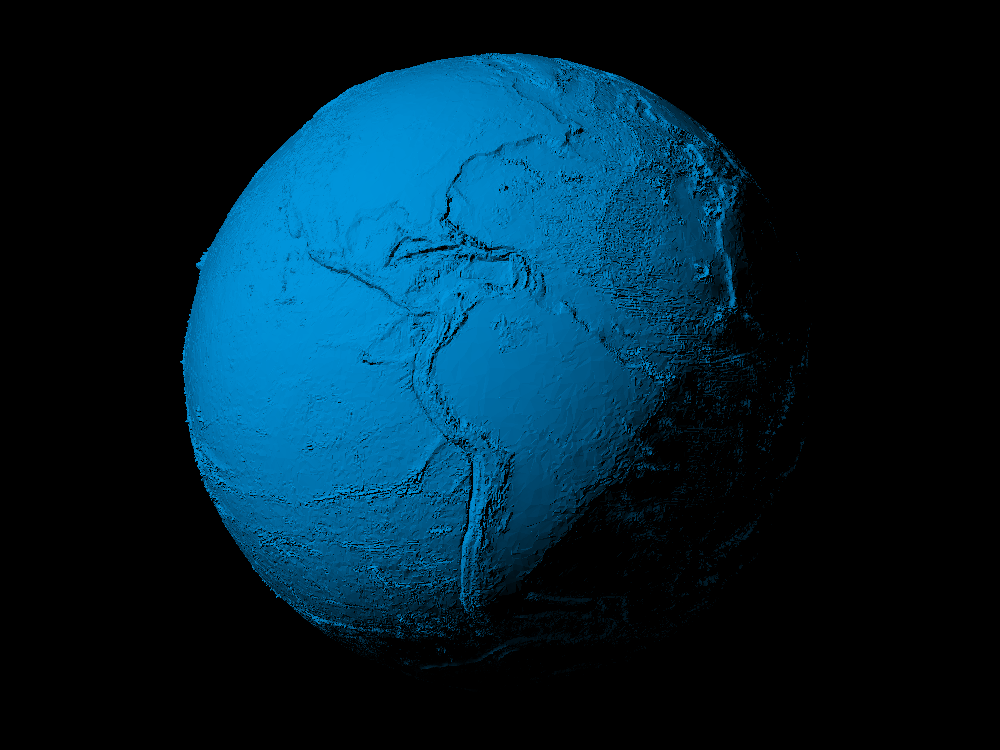
Earth with exaggerated topography scaled one in sixty million
prusaprinters
<p>This models were made using MATLAB R2016a with a topographical map of the Earth, including the seafloor. Like other models made by this way, the total relief is exaggerated, because proportional relief would make the terrain features too small to be noticed. Most of the coast lines are diffuse or not visible, because the continental shelf has not so different height than the coast. I've upload this model in 3 scales: <a href="https://www.thingiverse.com/tato_713/collections/one-in-sixty-million-scale">one in sixty million</a>, to compare with the biggest moons in the solar system; <a href="https://www.thingiverse.com/tato_713/collections/one-in-120-million-scale">one in 120 million</a>, to compare with terrestrial planets; and <a href="https://www.thingiverse.com/tato_713/collections/one-in-250-million-scale">one in 250 million</a> to compare with bigger objects like <a href="https://www.thingiverse.com/thing:3734762">exoplanets</a>, in this scale <a href="https://www.thingiverse.com/thing:3855305">Neptune</a> and <a href="https://www.thingiverse.com/thing:3881995">Uranus</a> are nearly 20cm in diameter.</p><p>The file's names explained:<i>name_1_x_10_y.stl</i> is 1 : x * 10 ^ y. So _1_6_10_7 is 1:600000000 or one in 60 million. </p><h4>Earth</h4><p>Earth is the only astronomical object known to be inhabited by any kind of life; the biggest terrestrial object in the Solar System; and the only one where water can be liquid in its surface. It also has the third most dense and massive atmosphere of a terrestrial body, after <a href="https://www.thingiverse.com/thing:3501867">Titan</a> and <a href="https://www.thingiverse.com/thing:3557664">Venus</a>. It has the biggest satellite, the <a href="https://www.thingiverse.com/thing:3419235">Moon</a>, compared to the mass and size of its parent body, of any planet. It is the only object with <a href="https://www.thingiverse.com/thing:4354702">current tectonic activity</a>. Many other planets and moons show signs of ancient activity, especially icy bodies. This is possible because most of the Earth's surface (70.8%) is covered by water, that reduce the viscosity of the crust, allowing the movement of the tectonic plates. This plates are moving constantly changing the position and distance of the continents. The Earth has also 5 pseudo satellites, one trojan asteroid in the L4 point, and its orbit is crossed by many <a href="https://www.prusaprinters.org/social/120859-tato_713/collections/49820">Near Earth Asteroids</a>.</p><ul><li><strong>Type:</strong> Planet.</li><li><strong>Orbit:</strong> Sun.</li><li><strong>Orbital period:</strong> 365.256 d</li><li><strong>Rotational period:</strong> 23h 56m 4.100s</li><li><strong>Composition:</strong> Rocky. Differentiated interior. N2 based atmosphere.</li><li><strong>Density:</strong> 5.514 g/cm3.</li><li><strong>Dimensions:</strong> 12756.2 km x 12713.6 km</li><li><strong>Model scale:</strong> 1:6x107 (21cm) 1:1.2x108 (10cm) 1:2.5x108 (5cm)</li></ul><h4>References</h4><ul><li><a href="https://visibleearth.nasa.gov/view.php?id=73934">Topography. From NASA 2019.</a></li><li><a href="https://visibleearth.nasa.gov/view.php?id=73963">Bathymetry. From NASA 2019.</a></li><li><a href="https://www.mathworks.com/matlabcentral/fileexchange/4512-surf2stl">Surf to STL function for MATLAB </a></li></ul><h3>Other astronomical objects</h3><p><a href="https://www.prusaprinters.org/social/120859-tato_713/collections/49826">Inner Solar System</a></p><p><a href="https://www.prusaprinters.org/social/120859-tato_713/collections/49832">Artificial</a></p><p><a href="https://www.prusaprinters.org/social/120859-tato_713/collections/49820">Near Earth Asteroids</a></p><p><a href="https://www.prusaprinters.org/social/120859-tato_713/collections/49291">Main Belt Asteroids</a></p><p><a href="https://www.prusaprinters.org/social/120859-tato_713/collections/49829">Jovian System</a></p><p><a href="https://www.prusaprinters.org/social/120859-tato_713/collections/49828">Saturn System</a></p><p><a href="https://www.prusaprinters.org/social/120859-tato_713/collections/49830">Uranian System</a></p><p><a href="https://www.prusaprinters.org/social/120859-tato_713/collections/49345">Neptunian System</a></p><p><a href="https://www.prusaprinters.org/social/120859-tato_713/collections/49827">Centaurs</a></p><p><a href="https://www.prusaprinters.org/social/120859-tato_713/collections/49833">Comets</a></p><p><a href="https://www.prusaprinters.org/social/120859-tato_713/collections/49341">Trans Neptunian Objects</a></p><p><a href="https://www.prusaprinters.org/social/120859-tato_713/collections/49824">Extrasolar Objects</a></p><p><a href="https://www.prusaprinters.org/social/120859-tato_713/collections/49837">Sky Maps</a></p><p><a href="https://www.prusaprinters.org/social/120859-tato_713/collections/49831">Ancient</a></p><p><a href="https://www.prusaprinters.org/social/120859-tato_713/collections/49822">Speculative</a></p><p><a href="https://www.prusaprinters.org/social/120859-tato_713/collections/49821">Science Fiction</a></p>
With this file you will be able to print Earth with exaggerated topography scaled one in sixty million with your 3D printer. Click on the button and save the file on your computer to work, edit or customize your design. You can also find more 3D designs for printers on Earth with exaggerated topography scaled one in sixty million.
